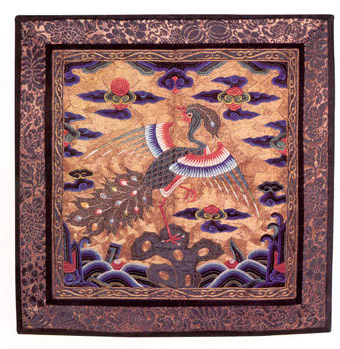|
The
District Magistrate

An
imperial civil servant's badge of rank. There were nine grades;
grade one being the most senior; the peacock denotes grade three.
The
county (xian) was the basic unit of imperial rule throughout
most of Chinese history. It is governed by an official usually
known as a district magistrate who, as well as being a judge,
was responsible for local security, tax collection, and conscription
for labour and military service. Like his superior, the provincial
governor, he attended all important local religious ceremonies.
The
district magistrate's office, the yamen, was always in
a walled county town and was itself surrounded by walls and
guarded by soldiers. The magistrate was aided by clerks and
servants called "yamen runners' and had to be on good terms
with the local scholar-gentry. Special handbooks reminded him
of his moral duties - to protect the people and be sympathetic
to them - and gave practical hints on the law and other matters.
To diminish the danger of nepotism or corruption, a magistrate
was never posted to his or his wife's native district.
From China:
The Land of the Heavenly Dragon edited by Professor Edward
L. Shaughnessy
|